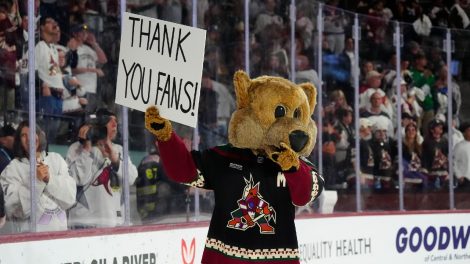The wait is over.
And maybe now the dam will break on the RFA market.
On Friday evening, the Toronto Maple Leafs and Mitch Marner put pen to paper on a new six-year, $65.358 million deal. For those counting (and I know you all are), that’s a $10.893 million cap hit.
Between Auston Matthews ($11.634 million), John Tavares ($11 million) and now Marner, the Maple Leafs hold three of the seven most expensive cap hits in the NHL. Add in William Nylander’s $6.962 million from his prolonged negotiation that came right down to the Dec. 1 deadline last season and those four players will now account for a combined $40.489 million against an $81.5 million cap.
It’s worth noting that with a new U.S. TV deal on the horizon in two years and revenues on the way from a 32nd franchise that will land in Seattle for the 2021-22 season, it can reasonably be expected the cap will increase before long. But for now, the Leafs will have to walk a tight rope because Marner’s contract sets a new precedent for RFAs — especially those coming off an entry-level contract.
Marner instantly becomes the second-highest paid winger in the NHL, behind only Artemi Panarin who counts for $11.643 million against the New York Rangers’ cap from a deal he signed this summer as the most sought-after UFA on the market. But as we know, with a cap that has risen many times over the years, the percentage of an AAV at the time of signing is the best way to compare deals across seasons.
Even there, Marner sticks out.[sidebar]
Among all active contracts, only three RFAs have signed for more than Marner’s 13.4 per cent of the salary cap. Centre Auston Matthews (14.6 per cent) is third on the list for his contract signed on Feb. 5 last season. Centre Connor McDavid (16.7) is second for a contract signed by the arguable world’s best player in July of 2017. And leading the way is Alex Ovechkin (16.8), the player who may one day pass Wayne Gretzky’s all-time goal record, for a 13-year deal he signed all the way back in 2008 that was done under a different CBA and would be illegal today. In other words, under the current agreement, Marner’s new contract is the richest given to an RFA winger.
So using cap percentage rather than AAV, here are comparable RFA deals to Marner — but in truth, his stands on its own.
For this purpose, we will not include William Nylander’s 12.9 cap hit percentage at the time of signing, since Year 1 of the deal was inflated due to how late it was signed in-season. His actual percentage for the first full year of the contract is 8.54 per cent.
Claude Giroux: 12.9 per cent of the cap at time of signing (July 4, 2013)
Contract: Eight years, $8.275 million AAV
The most significant difference between Giroux’s contract and Marner’s is that this was his third deal. In between Giroux’s ELC and long-term extension, he and the Flyers signed a three-year bridge deal. The eight-year commitment was also signed a year before the bridge deal expired and after three consecutive seasons in which Giroux averaged 0.93 points per game.
Nikita Kucherov: 11.9 per cent of the cap at time of signing (July 10, 2018)
Contract: Eight years, $9.5 million AAV
In terms of recency, this is the best comparable for Marner and really shows how unprecedented his contract is for wingers. But even still, Kucherov and the Lightning had previously signed a three-year bridge contract before this long-term extension. This eight-year deal was also signed a year before the bridge contract expired and after two incredible seasons of production: Kucherov had just finished posting 100 points when he agreed to this contract, which followed an 85-point campaign. The coming 2019-20 season will therefore be the first of Kucherov’s eight-year pact with the Lightning and it already looks like a steal. Keep in mind, the tax rate in Florida was a factor into keeping this AAV low.
[snippet id=4167285]
Patrick Kane: 11.09 per cent of the cap at time of signing (Dec. 2, 2009)
Contract: Five years, $6.3 million
Though this contract is no longer active, it is a true comparable and again expresses how much Marner’s contract stands out. Signed midway through the final season of his three-year entry-level contract, Kane’s five-year deal was a precursor to the contract he’s currently on that made him the highest-paid winger in the game for four years until Panarin (and now Marner) signed. Over the life of this five-year pact, Kane and the Blackhawks won two Stanley Cups, but they have only won three playoff games since his cap hit was upped to its current $10.5 million. In his first three NHL seasons leading up to his first post-ELC contract, Kane scored 72, 70 and 88 points and won the Calder Trophy.
THE RFA QUESTION
The only thing left to discover now is just what impact Marner’s contract will have on the rest of this RFA class. So far, Sebastian Aho is the lone big-name RFA forward to get a deal done this summer, and it took an offer sheet from Montreal to accomplish. His deal was much more in line with the market, a five-year pact with a $8.454 million AAV that comes in at 10.37 per cent of the cap. He’s also a centre, and centres tend to get paid the most of any position.
But there are an awful lot of wingers remaining out there. There is Patrik Laine, who is rumoured to want a deal with shorter term and Kyle Connor, who reportedly wants security. Matthew Tkachuk is still missing from Flames camp, as is Mikko Rantanen from Colorado’s. And then there’s Brock Boeser, who has 59 goals in 140 NHL games, but doesn’t have the leverage of being able to sign an offer sheet.
The thought was always that everyone was waiting for Marner to set the tone, but now that it’s been done will it really hurry up the rest of this class? Or will Marner’s supposed market-setting contract make these other negotiations more difficult?
Stay tuned — there’s a lot more to come on the RFA front.
[relatedlinks]









